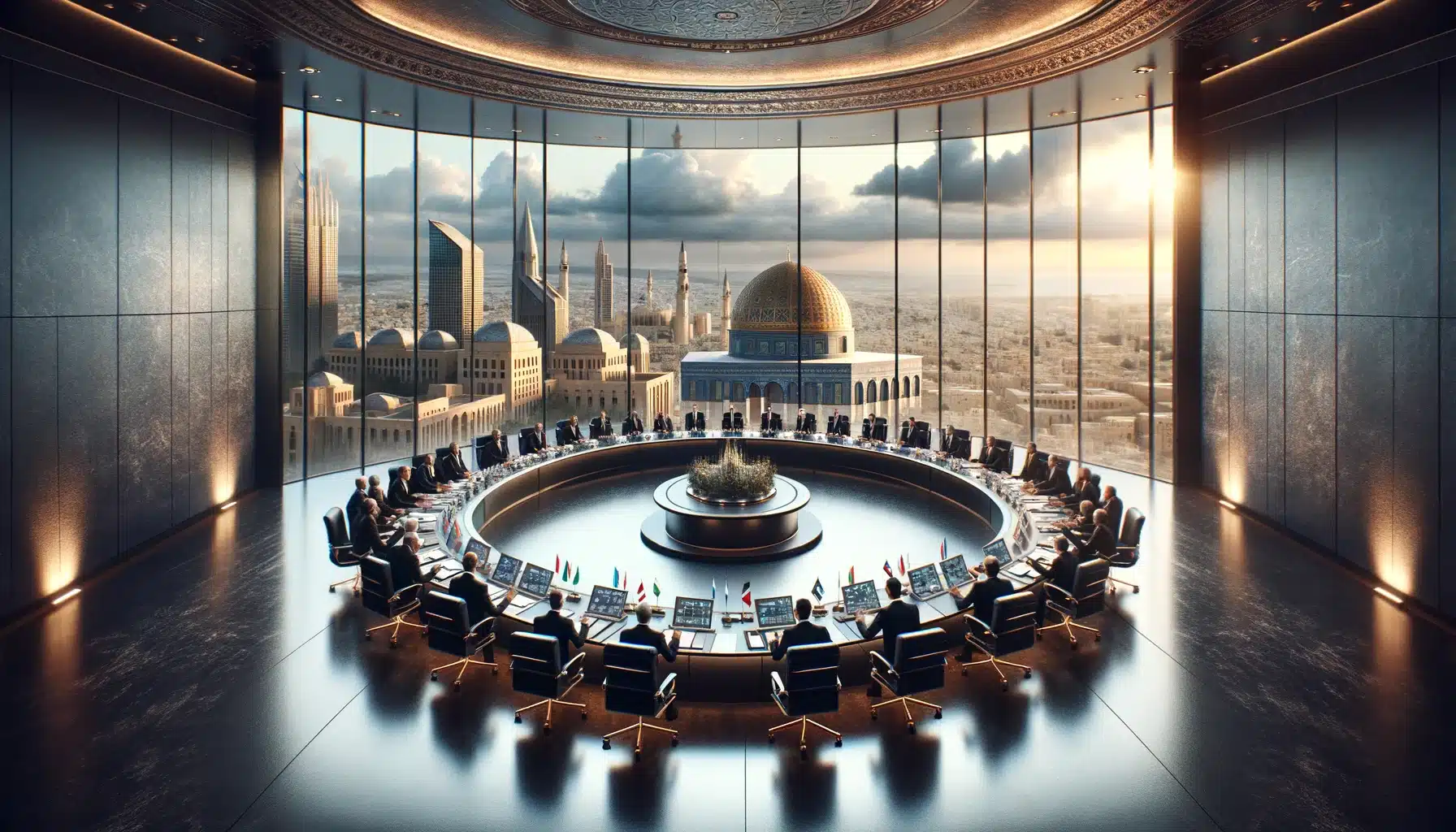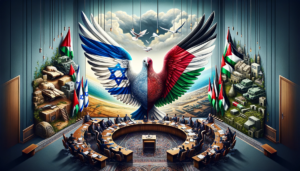Introduction to the Abraham Accords
In 2020, a remarkable event reshaped the Middle East’s geopolitical landscape. The signing of the Abraham Accords, a groundbreaking agreement, brought Israel and several Arab nations, including the United Arab Emirates (UAE), Bahrain, Sudan, and Morocco, into a new dawn of diplomacy. This historic initiative didn’t just aim to bridge decades of divisions; it opened a gateway to unprecedented cooperation, economic prosperity, and cultural exchange. Thus, these Accords stand as a powerful testament to the transformative potential of diplomacy, heralding a future where mutual understanding and peace are within reach.
The Abraham Accords, aimed to normalize relations between Israel and Arab nations. Four years on, in 2024, the accords remain intact but face significant challenges. Regional conflicts and criticism of Israel’s response to Hamas attacks have strained relationships. The accords’ future is uncertain.
Historical Context Behind the Abraham Accords
Understanding the impact of the Abraham Accords requires a look at the Israeli-Palestinian conflict’s lengthy history. This conflict has consistently influenced the region’s history, marked by many failed peace attempts. Many efforts to make peace have happened over the years. Then, the Abraham Accords appeared. They offered a new path forward, a chance for change.
Unpacking the Abraham Accords
Key Components and Agreements
Delving into the Abraham Accords, we find a multifaceted pact designed to foster a spirit of collaboration and unity. The agreement is built on several pillars:
- Diplomatic Relations: Marking a historic move, the Accords established formal diplomatic ties between Israel and the signatory Arab states, setting the stage for direct dialogue and cooperation.
- Economic Cooperation: At its heart, the Accords aimed to drive economic growth, laying the groundwork for trade agreements, joint ventures, and investment opportunities that promise mutual prosperity.
- Cultural and Educational Exchanges: Perhaps most importantly, the Accords sought to bridge hearts and minds through tourism, academic collaborations, and cultural programs, nurturing a foundation of mutual respect and understanding.
The essence of these components is captured in the following table, which highlights the transformative potential of the Accords across different spheres.
Table: Key Components of the Abraham Accords
Component | Impact |
Diplomatic Relations | Opens channels for dialogue, enhancing stability. |
Economic Cooperation | Fuels growth and innovation, benefiting all parties. |
Cultural and Educational Exchanges | Fosters understanding, breaking down long-standing barriers. |
This table provides a snapshot of the foundational elements of the Abraham Accords, highlighting the broad areas of cooperation that the agreement covers.
Signatory Nations and Their Objectives
The nations that joined the Abraham Accords each brought their aspirations to the table. Israel, seeking to normalize its regional presence, saw an opportunity to bolster its security and unlock new economic partnerships. Conversely, the Arab nations, driven by strategic and economic incentives, envisioned a path toward enhanced stability and prosperity. United in their pursuit of a brighter future, these countries embarked on a journey of collaboration and mutual benefit.
Table: Objectives of Signatory Nations
Country | Objectives |
Israel | Enhance regional security and diplomatic standing. |
UAE | Drive economic growth, gain access to advanced technology, and promote regional stability. |
Bahrain | Seek economic opportunities and strengthen security measures in the region. |
Sudan | Improve international relations and unlock economic benefits. |
Morocco | Leverage economic and technological advancements while contributing to regional peace efforts. |
This table outlines the diverse motivations behind each signatory nation’s decision to join the Abraham Accords, reflecting the multifaceted benefits that the agreement is perceived to offer.
Effects on the Israeli-Palestinian Conflict
Implications for Peace Efforts
Some people think the Accords could help restart peace talks. Others feel it might ignore the Palestinian issue. It’s a mixed bag, and it shows how hard the path to peace can be.
The Abraham Accords introduced a dynamic shift in the narrative surrounding the Israeli-Palestinian conflict. Although not directly addressing the conflict, the Accords offer a conducive backdrop for future peace initiatives. However, they also underscore the importance of engaging Palestinian aspirations in the peace process, ensuring that the path forward is inclusive and equitable.
Palestinian Response and Its Consequences
The Palestinian leadership’s apprehension toward the Accords highlights the need for a peace process that genuinely addresses their quest for statehood and dignity. Moving forward, it’s crucial to weave Palestinian perspectives into the broader fabric of Middle Eastern diplomacy, ensuring that progress does not come at their expense.
Alterations in Regional Alliances
Shifts in Middle Eastern Political Dynamics
The Accords have significantly altered the region’s political alliances, encouraging a reevaluation of long-standing relationships. This new diplomatic landscape, based on shared interests rather than historical grievances, suggests a promising shift towards a more interconnected and peaceful Middle East.
Influence of External Powers
The instrumental role of the United States in facilitating the Accords, along with the nuanced contributions of other global powers, underscores the international dimension of the Middle East’s path to peace. This global involvement highlights the universal stakes in the region’s stability and prosperity.
Global Implications of the Abraham Accords
Impact on International Relations
The Abraham Accords’ influence extends beyond the Middle East, offering a new paradigm for international diplomacy. By showcasing the efficacy of economic and security cooperation in bridging divides, the Accords provide valuable insights for resolving conflicts worldwide, underscoring the power of unity over division.
Challenges and Future Directions
Yet, challenges remain, including ensuring the inclusivity of all stakeholders and navigating the complex political landscape to realize the full potential of the Accords.
The road ahead for the Abraham Accords is laden with challenges, from ensuring inclusivity to navigating the complexities of implementation. The enduring success of the Accords will hinge on the collective commitment to dialogue, cooperation, and a shared vision for a harmonious Middle East.
Critiques and Controversies Surrounding the Accords
Critics argue that the Accords need to do more to address the Palestinian cause and warn of the risk of deepening regional divisions. Addressing these concerns is essential for the Accords’ success.
The mixed global reaction to the Accords reflects the complex nature of Middle Eastern politics and the ongoing debate about the best path to peace and stability.
Conclusion: The Abraham Accords’ Legacy
As we look to the future, the Abraham Accords stand as a monumental achievement in the quest for peace in the Middle East. By fostering new alliances and opening avenues for collaboration, they offer a blueprint for transforming regional dynamics. However, the journey towards a comprehensive peace is ongoing, and the Accords’ true legacy will be measured by their impact on fostering a peaceful, stable, and prosperous region for all its inhabitants.





